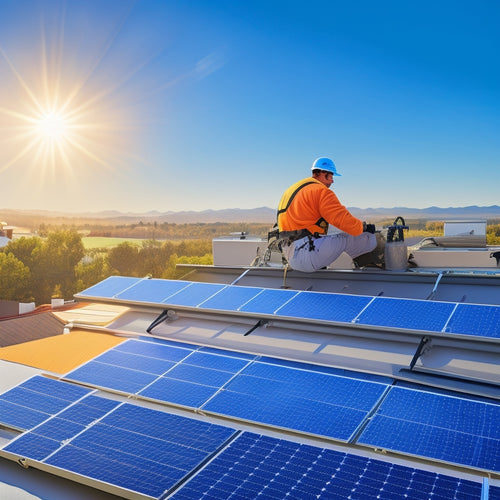
Best Off-Grid Solar Systems for Remote Locations
Share
You're likely contemplating off-grid solar systems for remote locations because you need a reliable source of energy despite being far from the grid. Selecting the right system requires careful evaluation of your specific energy needs, panel efficiency, and charge controller type, among other key factors. Renogy, Goal Zero, OutBack Power, Magnum Energy, and Schneider Electric are top brands to contemplate. When evaluating systems, reflect on capacity, panel efficiency, charge controller type, battery type, and monitoring features. By understanding your energy needs and these key factors, you'll be able to choose the best off-grid solar system for your remote location, and exploring these details further will help you make an informed decision.
Key Takeaways
- Consider top off-grid solar system brands like Renogy, Goal Zero, and OutBack Power for reliability and efficiency in remote locations.
- Assess energy needs by calculating system load, battery bank sizing, and energy usage patterns to ensure adequate power supply.
- Choose high-efficiency solar panels with durable designs, improved durability, and warranties to maximize energy production in low-light conditions.
- Select compatible charge controllers and inverter types, such as MPPT and PSW, to optimize energy harvesting and conversion efficiency.
- Regular system inspection, monitoring, and maintenance are crucial to ensure optimal performance, troubleshoot issues, and extend system lifespan.
Top Off-Grid Solar System Brands
When venturing into off-grid solar systems, selecting a reliable brand is vital to guarantee a seamless and efficient energy supply. You'll want a brand that can provide high-quality components, reliable performance, and exceptional customer support.
To make an informed decision, it's important to research and compare top brands. Brand comparisons can be overwhelming, but focusing on user reviews and ratings can help narrow down your options. Look for brands with high ratings and positive reviews from satisfied customers.
Renogy, for instance, is a popular choice among off-grid enthusiasts, known for its affordable and efficient solar panels. Another contender is Goal Zero, which offers a range of portable and reliable solar power systems.
Other top brands to examine include OutBack Power, Magnum Energy, and Schneider Electric. Each brand has its unique strengths and weaknesses, so it's important to research and compare their products before making a purchase.
Key Features to Consider
You've narrowed down your options to the top off-grid solar system brands, but now it's time to examine the key features that'll guarantee your system meets your energy needs. With solar technology advancements, you can enjoy energy independence benefits like reduced reliance on the grid and lower energy costs. When selecting an off-grid solar system, consider the following key features:
| Feature | Description | Importance |
|---|---|---|
| System Capacity | Measured in watts (W), it determines the system's energy output | High |
| Panel Efficiency | Affects the system's energy output per unit area | Medium |
| Charge Controller Type | MPPT (Maximum Power Point Tracking) or PWM (Pulse Width Modulation) | High |
| Battery Type and Capacity | Affects the system's energy storage and backup capabilities | High |
| Monitoring and Tracking | Enables real-time system performance monitoring and troubleshooting | Medium |
These features will impact your system's performance, reliability, and overall value. By understanding their importance, you'll be able to make an informed decision and choose an off-grid solar system that meets your unique energy needs.
Remote Location Solar Needs
In remote locations, energy access can be a significant challenge, and off-grid solar systems offer a reliable solution.
You're likely considering solar energy solutions for your remote location to achieve sustainable living. To determine the best off-grid solar system for your needs, it's crucial to evaluate your energy requirements.
When evaluating your energy needs, consider the following factors:
-
Energy usage patterns: Identify your daily energy consumption, including the types of appliances you use and their power ratings.
-
Seasonal energy demands: Consider how your energy needs change throughout the year, factoring in seasonal variations in temperature and daylight hours.
-
Backup power requirements: Determine if you need a backup power source, such as batteries, to guarantee continuous energy supply during periods of low solar irradiance or at night.
Off-Grid System Sizing Guide
You'll need to determine the total system load calculation to guarantee your off-grid solar system can handle the electrical requirements of your remote location.
This involves calculating the total watt-hours per day of all your appliances, lighting, and other devices.
You'll also need to size your battery bank correctly to provide sufficient backup power during periods of low sunlight or at night.
System Load Calculation
Accurate system load calculation is essential to designing an off-grid solar system that meets your energy needs. A well-calculated load guarantees your system can handle the power requirements of your appliances, lights, and other electrical devices.
To get it right, you'll need to conduct an energy consumption analysis to determine your total daily energy load.
There are various load estimation methods to choose from, including:
-
Watt-hour analysis: This involves calculating the total watt-hours required by each appliance and device over a 24-hour period.
-
Amp-hour analysis: Similar to watt-hour analysis, but focuses on the ampere-hours required by each device.
-
Load profiling: This method involves monitoring your energy usage patterns over time to identify peak demand periods and total daily energy consumption.
Battery Bank Sizing
Energy independence relies on a well-sized battery bank, the heart of your off-grid solar system. To get it right, you'll need to take into account several factors, including battery chemistry, capacity planning, discharge rates, temperature effects, and cycle life.
| Battery Type | Cycle Life | Depth of Discharge (DOD) |
|---|---|---|
| Lead-Acid | 500-1000 cycles | 50% |
| Lithium-Ion | 3000-5000 cycles | 80% |
| Nickel-Cadmium | 1000-2000 cycles | 80% |
| Nickel-Metal Hydride | 500-1000 cycles | 80% |
| Sodium-Ion | 2000-3000 cycles | 80% |
When sizing your battery bank, you'll need to balance capacity planning with load forecasting to guarantee you have enough power to meet your energy needs. Take into account your daily energy usage, the number of days of autonomy you require, and the maximum discharge rate. Don't forget to factor in temperature effects, as high or low temperatures can impact battery performance. Proper maintenance practices, such as monitoring and charging, will also help extend the life of your battery bank. Finally, take into account expansion options for future energy needs.
Best Solar Panels for Off-Grid
When selecting the best solar panels for your off-grid system, you'll want to take into account high-efficiency options that maximize energy production in remote locations with limited space.
Durable panel designs are also essential, as they must withstand harsh environmental conditions and last for many years.
High-Efficiency Solar Options
Across remote locations, you're likely to encounter varying levels of sunlight, which is why high-efficiency solar options are essential for maximizing energy production.
To get the most out of your off-grid solar system, you need panels that can capture energy efficiently, even in low-light conditions.
Thanks to solar technology advancements and photovoltaic innovations, high-efficiency solar panels are now more accessible than ever.
Here are three key benefits of high-efficiency solar options:
-
Increased energy output: High-efficiency panels can produce more power per hour of sunlight, making them ideal for remote locations with limited sunlight.
-
Reduced space requirements: With high-efficiency panels, you can generate the same amount of energy using fewer panels, saving space and reducing installation costs.
-
Improved durability: High-efficiency panels are often built with more durable materials, ensuring they can withstand harsh weather conditions and last longer.
Durable Panel Designs
Three key factors contribute to a solar panel's durability: its frame, glass, and anodizing. You want a frame that can withstand extreme weather conditions, such as high winds and heavy snow loads. Look for frames made from corrosion-resistant materials like anodized aluminum.
The glass should be tempered and resistant to impact, ensuring it can handle hail and other debris. Anodizing, a process that provides a protective coating, adds an extra layer of weather resistance.
When selecting a durable solar panel, consider aesthetic designs that prioritize functionality. Installation durability is vital, so opt for panels with reinforced corners and secure mounting systems.
Check panel warranties, which should cover performance and durability for at least 25 years. High-performance ratings are significant, but don't compromise on durability for the sake of efficiency.
If you need to transport panels to your remote location, look for lightweight options with modular designs that make installation easier. By prioritizing these factors, you'll get a solar panel that will provide reliable power for years to come.
Deep Cycle Battery Options
You'll need a reliable deep cycle battery to store excess energy generated by your off-grid solar system, especially during periods of low sunlight or at night.
This is essential for guaranteeing a steady power supply when the sun isn't shining.
When selecting a deep cycle battery, consider the following key factors:
-
Battery Lifespan: Look for batteries with a long lifespan to minimize replacement costs and reduce waste. A longer lifespan also means less maintenance and more reliable energy storage.
-
Depth of Discharge (DOD): A higher DOD means you can use more of the battery's capacity, reducing the overall cost per kWh of energy storage.
-
Cycle Life: Choose batteries with a high cycle life to guarantee they can handle the repeated charge and discharge cycles that come with off-grid solar systems.
Charge Controllers for Remote
With your deep cycle battery selected, it's time to focus on regulating the energy flow from your solar panels to prevent overcharging or undercharging. This is where a high-quality charge controller comes in.
As you're dealing with remote locations, you need a controller that can efficiently manage the energy flow while withstanding harsh environmental conditions.
Look for a charge controller with high solar charge efficiency, typically above 95%, to minimize energy losses. This will guarantee you're getting the most out of your solar panels.
Additionally, consider a controller with remote monitoring solutions, allowing you to keep tabs on your system's performance from anywhere. This feature is especially significant in remote locations where on-site monitoring mightn't be feasible.
When selecting a charge controller, pay attention to its maximum power point tracking (MPPT) capability, which optimizes energy harvesting from your solar panels.
Also, verify the controller is compatible with your battery type and can handle the system's voltage and current requirements.
Inverters for Off-Grid Systems
You'll need to select an inverter that suits your off-grid system's requirements, and there are several types to take into account, including pure sine wave, modified sine wave, and square wave inverters.
If you're looking to sell excess energy back to the grid, you'll also need to investigate grid tie options.
When evaluating inverter options, be sure to scrutinize their power conversion efficiency, as even small differences can greatly impact your system's overall performance.
Inverter Types
In the domain of off-grid solar systems, inverters play a vital role in converting DC power from solar panels into usable AC power for remote locations.
When selecting an inverter for your off-grid system, it's important to take into account the type that best suits your needs.
You'll come across three primary inverter types:
-
Modified Sine Wave (MSW) Inverters: These inverters provide a stepped sine wave output, which is suitable for most appliances. They're a cost-effective option but may not be compatible with all devices.
-
Pure Sine Wave (PSW) Inverters: These inverters produce a pure sine wave output, making them compatible with sensitive electronics and motors. They're more expensive than MSW inverters but offer higher inverter efficiency.
-
Grid-Tie Inverters with Battery Backup: These inverters combine the benefits of grid-tie systems with battery backup, allowing you to sell excess energy to the grid while providing backup power during outages. They're a more complex and expensive option, but they offer advanced inverter technologies.
When choosing an inverter, take into account factors such as your power requirements, budget, and the type of appliances you need to support.
Grid Tie Options
Grid-tie systems, a hybrid solution, enable you to sell excess energy to the grid while providing backup power during outages. This setup allows you to generate revenue by selling excess energy back to the grid and offsetting your energy bills. As a result, you can reduce your reliance on traditional energy sources and lower your carbon footprint.
The grid tie benefits are numerous. You can optimize your energy production and consumption by storing excess energy in the grid and drawing from it when needed. This setup also provides backup power during outages, guaranteeing your critical systems remain operational. Additionally, grid-tie systems can increase your property value and provide a sense of energy independence.
However, there are also grid tie drawbacks to evaluate. One major limitation is that grid-tie systems require a connection to the grid, which may not be feasible in remote locations.
Moreover, you'll need to verify your system complies with local regulations and grid codes, which can be complex and time-consuming. By assessing these benefits and drawbacks, you can determine if a grid-tie system is the right fit for your off-grid solar needs.
Power Conversion Efficiency
Utilizing solar energy in remote locations demands efficient power conversion, which is where inverters for off-grid systems come into play.
When choosing an inverter, you'll want to prioritize power conversion efficiency to maximize the energy you harvest from the sun. This is critical in off-grid systems, where energy storage is limited and every watt counts.
To evaluate an inverter's performance, look for the following solar efficiency metrics:
-
Peak Efficiency: The highest efficiency rating an inverter can achieve under ideal conditions.
-
European Efficiency: A weighted average of efficiency ratings at various input voltages, providing a more realistic representation of real-world performance.
-
California Energy Commission (CEC) Efficiency: A standardized metric that takes into account temperature, voltage, and other factors to provide a thorough efficiency rating.
Mounting and Installation Tips
How can you guarantee your off-grid solar system is securely fastened to withstand harsh weather conditions and environmental factors in remote locations?
You'll need to focus on proper mounting techniques to make certain your system remains upright and functional. Start by evaluating the terrain and selecting a mounting structure that suits the site's conditions. For instance, you might opt for a ground-mounted system in areas with high winds or a roof-mounted system for areas with limited space.
When it comes to installation safety, always follow the manufacturer's guidelines and take necessary precautions to avoid electrical shock or physical harm. Be certain to secure all electrical connections and confirm the system is properly grounded.
Consider hiring a professional if you're not experienced in solar installations. Additionally, always inspect the system after installation to verify all components are securely fastened and functioning as intended.
Maintenance and Monitoring Essentials
Reliability hinges on regular maintenance and vigilant monitoring, ensuring your off-grid solar system operates at peak performance despite the harsh conditions in remote locations.
You'll want to prioritize routine checks to identify and address potential issues before they escalate into costly problems.
To keep your system running smoothly, incorporate the following essentials into your maintenance routine:
-
Regular inspections: Schedule regular checks to inspect your system's components, ensuring they're clean, secure, and functioning correctly.
-
Performance monitoring: Employ data logging and software tools to track your system's performance, identifying areas for improvement and optimizing energy production.
-
Troubleshooting techniques: Develop a plan for diagnosing and resolving common issues, such as inverter faults or battery malfunctions, using remote diagnostics and on-site visits when necessary.
Frequently Asked Questions
Can I Use Off-Grid Solar Systems for Backup Power During Outages?
A million times yes, you can rely on off-grid solar systems for backup power during outages, achieving energy independence and utilizing solar power to keep your lights on, even when the grid goes dark.
Do Off-Grid Systems Require Regular Cleaning and Maintenance?
You'll need to regularly clean and maintain your off-grid solar system to guarantee ideal system efficiency and maximize panel lifespan; neglecting maintenance can lead to reduced energy output and premature wear.
Can I Add a Generator to My Off-Grid Solar System?
You can add a generator to your off-grid solar system, ensuring generator compatibility with your existing setup; consider hybrid systems that seamlessly integrate solar power with generator backup for reliable, efficient energy production.
Are Off-Grid Solar Systems Suitable for Extreme Weather Conditions?
You'll find that off-grid solar systems are designed to withstand extreme temperatures, but it's essential to assess system durability before installation, ensuring your setup can handle harsh weather conditions and provide reliable power when you need it most.
Can I Expand My Off-Grid Solar System in the Future?
Like a puzzle, you can piece together a scalable system, and yes, you can expand your off-grid solar setup in the future with ease, thanks to system scalability and seamless future upgrades that let you add more power as your needs grow.
Related Posts
-

Waterproofing Solar Panels for Vehicles: A Step-by-Step Guide
When waterproofing solar panels for your vehicle, start by evaluating your energy requirements and selecting the righ...
-

Top 10 Tips for Buying Car Accessories Online
When purchasing car accessories online, you should take proactive steps to avoid low-quality or incompatible products...
-

3 Essential Steps for Solar Electricity Installation
To guarantee a successful solar electricity installation, you'll need to follow three essential steps. First, assess ...


